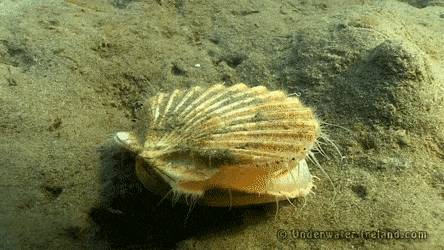How Does A Scallop Move

The ocean is a place of constant dynamic movement. Fish use their fins to push water away from themselves, and because every activeness has an equal and opposite reaction, they therefore move forrard. Some cephalopods use jet propulsion, constricting their mantle cavity to push water out through siphons, allowing them to jet forward like a deflating balloon. And other life forms canvas the seas on constantly moving currents , indirectly harnessing the ability of the sun and earth.
Bivalves are a fairly sedentary agglomeration past comparison. While nearly bivalves have a planktonic larval form, when they settle they are constrained to a fairly small area within which they tin couch or scramble around with their muscular anxiety.

Only some bivalves have evolved to move at a quicker rate. The most famous swimming bivalves are the scallops, which have evolved to use jet propulsion, similar to their very distantly related cephalopod relatives. Simply unlike the cephalopods, scallops evolved to use their hinged shells to aid this process!

Many filter-feeding bivalves use their shell valves as a biological bellows to pull in water for the purposes of sucking in food, or even to aid in digging, but scallops have developed another use for this action, to enable propulsion. Scallops draw in water by opening their valves to create a vacuum which draws in h2o to their sealed mantle crenel. They and then rapidly close their valves using their strong adductor muscles to pull them together, which pushes the h2o back through vents in the rear hinge area, propelling the scallop forward.

Using this strategy, scallops tin evade predators and distribute themselves to new feeding sites. It's a surprisingly constructive swimming technique, with the queen scallop able to motion 37 cm/2nd, or over five body lengths per 2d! Michael Phelps would have to swim at well-nigh 35 km/h to lucifer that relative speed (his bodily highest speed is effectually 1/3 of that). I'm certain sustaining that speed would exist tiring for Mr. Phelps, though, and it'due south the same for scallops, only using their swimming for short-distance swims.
(video from Supplemental Materials of Robertson et al. 2019)
A recent paper from a squad in Switzerland just came out describing an effort to engineer a robot which imitates the scallop's elegant and unproblematic pond method. The resulting totally ambrosial "RoboScallop" closely imitates the design of a scallop, using a pair of hinged valves with rear openings to let the motion of water backward. The internal crenel is sealed by a safe membrane draped across the forepart so that all water is forced through these rear vents when the Roboscallop snaps shut.

As seen in the diagram above, the rhythm and relative velocity of opening vs closing is important to make sure the RoboScallop actually moves forward. If the scallop opened every bit quickly as it closed, it would just rock back in forth. It instead opens slowly so that information technology does not depict itself backward at the aforementioned rate that it tin push itself forward. The researchers had to do quite a bit of calibration to become these rates correct (equating to about 1.4 "claps" per 2d), just once they did, they concluded upward with a RoboScallop that can generate most the same force of forward movement (1 Newton) as a real scallop (1.15 Newtons), and like rates of speed.
This paper actually fascinated me because it is merely the latest in a long line of successful applied science projects imitating the ingenuity of development. Other marine robots have been made which emulate the locomotion of fish, manta rays, bounding main snakes and other forms of swimming. And now we accept a mollusk! Let me know when I tin buy one to play with in my pool.
How Does A Scallop Move,
Source: https://dantheclamman.blog/2019/02/13/how-does-a-scallop-swim/
Posted by: hillpoetastords1990.blogspot.com


0 Response to "How Does A Scallop Move"
Post a Comment